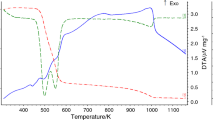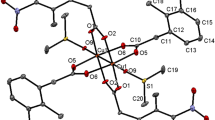Abstract
The complexation processes between Fe3+, Y3+, Cd2+, Sn4+, Ce3+ and Au3+ metal cations with macrocyclic ligand, 4′-nitrobenzo-15-crown-5 (4′NB15C5), were studied in acetonitrile (AN), methanol (MeOH) and nitromethane (NM) solvents at different temperatures using conductometric method. The conductance data show that the stoichiometry of the complexes formed between this macrocyclic ligand and Cd2+, Au3+ cations is 1: 1 (ML), but in the case of Fe3+, Y3+ and Ce3+ metal cations, 2: 1 (M2: L) and 2: 2 [M2: L2] complexes are formed in nitromethane solutions. The results show, that the selectivity of 4’NB15C5 for the studied metal cations in methanol solutions at 15°C is: Sn4+ > Cd2+ > Y3+ > Fe3+ ∼ Ce3+ > Au3+, but in the case of acetonitrile, the stability order was found to be: Y3+ > Au3+ > Fe3+ > Cd2+. The values of stability constants of the 1: 1 [M: L] complexes were determined from conductometric data using a GENPLOT computer program. The values of thermodynamic parameter (ΔH o c and ΔH o c ) for formation of the complexes were obtained from temperature dependence of the stability constants, using the van’t Hoff plots. The results show that the values of standard enthalpy (ΔH o c ) and standard entropy (ΔH o c ) change with the nature of the non aqueous solvents.
Similar content being viewed by others
References
R. M. Izatt, K. Pawlak, J. S. Bradshow, and R. C. Bruening, Chem. Rev. 91, 1721 (1991).
G. H. Rounaghi and M. S. Kazemi, Asian J. Chem. 20, 366 (2008).
G. H. Rounaghi, Shahri E. Esmail, and A. Soleimani, J. Chin. Chem. Soc. 51, 923 (2004).
G. H. Rounaghi, G. H. Gerey, and M. S. Kazemi, J. Incl. Phenom. Macro. 55, 167 (2006).
R. K. Mahajan, M. Kumar, V. Sharam, and I. Kaur, Talanta 58, 445 (2002).
J. Jeng and J. S. Shih, Analyst. 109, 641 (1984).
M. F. Mousavi, S. Shahari, N. Alizadeh, and M. Shamsipur, Anal. Chim. Acta 414, 189 (2000).
A. Morin, F. Beniere, and J. Simonet, J. Chem. Soc., Faraday Trans. 87, 1393 (1991).
N. Kitagawa, Y. Kaminoh, and M. Takasaki, Ueda Issaku, J. Pharm. Sci. 79, 344 (2006).
S. V. Prabhu, P. R. Baldwin, and L. Kryger, Electroanal. 1, 13 (2005).
S. V. Demin, V. I. Zhilor, A. Yu. Tsivadze, et al., Russ. J. Inorg. Chem 51(10), 1678 (2006).
G. H. Rounaghi, Z. Eshagi, and E. Ghiamati, Talanta 43, 1043 (1996).
O. Quadrat and P. Bradna, Makromol. Chem. 178, 2953 (2003).
C. Kalidas, G. Heftor, and Y. Marcus, Chem. Rev. 100, 828 (2000).
Author information
Authors and Affiliations
Corresponding author
Additional information
The article is published in the original.
Rights and permissions
About this article
Cite this article
Rounaghi, G.H., Soorgi, M.H. & Kazemi, M.S. Effect of non-aqueous solvents on stoichiometry and selectivity of complexes formed between 4′-nitrobenzo-15-crown-5 with Fe3+, Y3+, Cd2+, Sn4+, Ce3+ and Au3+ metal cations. Russ. J. Inorg. Chem. 55, 355–360 (2010). https://doi.org/10.1134/S0036023610030095
Received:
Published:
Issue Date:
DOI: https://doi.org/10.1134/S0036023610030095




